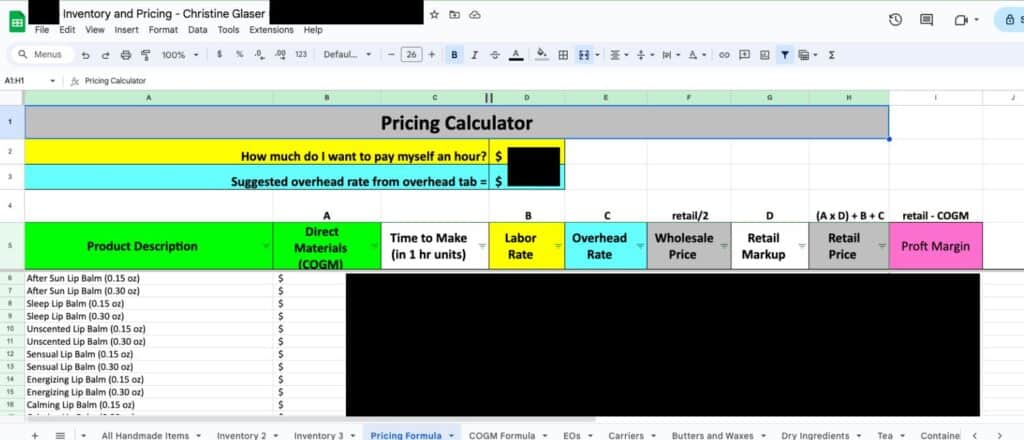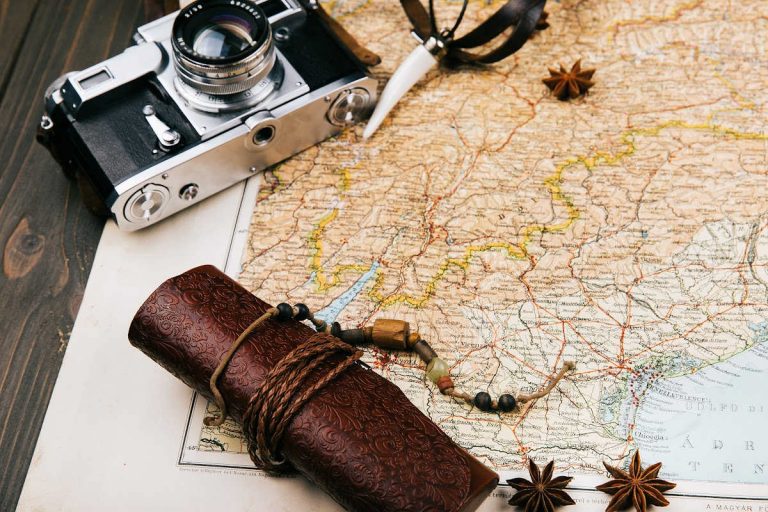Pricing your DIY skin care products correctly is essential if you want to turn that hobby into a business.
If you have only made products at home for your family thus far, the pricing details and formula below will surprise you.
You’ve been told on Pinterest that ‘you can make a lip balm for twenty cents a pop!’…so you’re probably thinking that lip balms sold for $5.00 per tube are CRAZY high.
If you are looking to actually make money (or evening a living!) with your handmade skin care line, you have to factor in much more than just material costs.
Get out your calculators, receipts, and keep scrolling!

This post may contain affiliate links, meaning I get a commission if you decide to make a purchase through my links (at no cost to you). Please read the disclosure for more information.
Pricing DIY Skin Care for Profit (Correctly!!!)
I would like to take a moment to emphasize the fact that I am NOT a CPA.
Obviously.
But I am a certified aromatherapist, essential oil specialist, and organic skin care maker – a successful business owner for years. Lots of experience.
And I STILL got a wake-up call as to the training, guidance, and support I needed from a qualified professional when it comes to pricing (and inventory & taxes).
I earned a profit for YEARS on my business – but NOT the profit that SHOULD HAVE been coming in.
Not by a long shot.
So much was missing from the initial pricing formula I was using:
- An hourly wage for myself.
- The cost of the educational courses I was taking simultaneously.
- Accounting software, insurance, and other professional service fees.
- A brand-specific profit margin that would still allow for a healthy income even during huge sales times, such as Black Friday.
A few years ago, I started using the spreadsheets by Paper + Spark to help me price my products, as well as prepare all of my sales and inventory information for the beloved tax time.
In my over a decade of being in this industry, never before have I felt so confident in my prices, how to navigate discount inquiries, and knowing where every penny of my hard-earned dollars is going (even when it comes to those e-commerce fees that seem sneaky, but they really just tend to stack up over time).
Whether you are a new business owner, a seasoned business owner, or just thinking about the idea of a business, it will be worth every second of your time to at least glance at the details below about this online pricing system that Janet made specifically for handmade entrepreneurs.
(And if you are a newbie reading this article, thank your lucky stars you’re getting this advice at the beginning…it is ZERO fun to switch systems over when you already have one set up.)
Base Formula for Pricing DIY Skin Care Products
The formula below for pricing DIY skin care was my own version of several examples that I had seen online when I first started my business.
I used this formula for my shop and it somehow earned me enough so that I could quit my day job and become a work-from-home mom (WARNING – I WAS STILL DOING IT WRONG!!! KEEP READING FOR CORRECT PRICING!):
Base Price = [(Ingredients) + (Packaging) + (Listing Fees)] x Transaction Fees
If this formula is familiar to you, you’ll understand that the below details were (what I assumed was) essential to figuring out the pricing formula:
⭐️ Ingredients (including shipping fees)
⭐️ Packaging (including shipping fees)
⭐️ E-commerce site listing fees, transaction fees, shipping fees
In actuality, I learned SUPER late in my business journey that I was missing several key things:
Base Price = Direct Materials (Ingredients + Packaging) + Labor Rate* + Overhead Rate**
*I actually get to pay myself per hour?!?
** Includes ALL e-commerce fees, plus office fees such as your ink, printer, Canva subscription, Ad costs, business insurance, your PO Box, educational resources, etc.)
To give you an overview (my Type A readers, you’ll love this!), you’ll be thrilled to see it all laid out perfectly in the Pricing Formula tab in the Inventory Cost & Pricing Spreadsheet:

Base Pricing Strategy for DIY Organic Lip Balm
To demonstrate how this works, I’ll be using my organic lip balm recipe.
Please understand that all prices below are for tutorial purposes only and don’t reflect current prices of ingredients, packaging, and e-commerce fees.
Breakdown of Skincare Product Ingredient Costs
In the Inventory Cost & Pricing Spreadsheet screenshot shown below, you can hopefully see that each one of my ingredient categories has its own tab in the workbook.
This helps me to document the exact ingredient, size, cost, units purchased, per unit cost (which is calculated for me thanks to the preset spreadsheet formulas), the source, and the date of purchase.
So not only do I know exactly how I came up with the per unit cost, but this also helps me with all of my inventory and bookkeeping needs as well (not to mention the ever-important detail of ingredient shelf life that we should be documenting as well for our skin care products).

Breakdown of Skincare Product Packaging Costs
In another Inventory Cost & Pricing Spreadsheet screenshot shown below, you can hopefully see that each one of my packaging categories has its own tab in the workbook.
This screenshot is specifically for the breakdown of my label costs, and it allows me to put in the size of the label, shape, cost, units purchased, per unit cost, source, and date of purchase.
Again, helping me out NOW with my pricing – and also helping me out later with all of my inventory and bookkeeping tasks.

Breakdown of Skin Care Business Overhead Fees
In my previous calculations (before being introduced to Paper + Spark), it’s not that I completely ignored these business costs.
I just didn’t know exactly where to put them, so they ended up being an estimation tacked onto my final product prices.
This screenshot below of the Cost & Pricing Spreadsheet shows how to take annual business expenses, cost of indirect materials, and estimated products created per year to come up with an ACTUAL overhead rate (instead of a guesstimation).

Cost of Inventory Calculator
This next section is where a HUGE benefit of the Cost & Pricing Spreadsheet shines through.
The Cost of Inventory (Cost of Goods) that you have to report on your tax forms.
This Cost of Goods ‘detail’ is missing from the bookkeeping software that is actually recommended to you on the most popular marketplaces and e-commerce platforms.
It absolutely blows my mind and is SO CRAZY that handmade marketplaces suggest a platform that DOESN’T DO what handmade makers NEED it to do. I mean, it’s astonishing.
And downright irresponsible if you ask me.
It gets me so worked up.
Instead of sitting in frustration (which I totally could all day in this situation), I’ll just be grateful that Janet created a tool that is specifically FOR makers and does the job correctly.

Finished Goods Inventory
How many times have you had a customer reach out for a special discount for a bulk purchase? Or have tried to decide off the top of your head what kind of a sale to put on for Black Friday Cyber Monday?
If you follow all of the directions for setting up the Cost and Pricing Spreadsheet (Janet provides PDF instructions, step-by-step YouTube video instructions, AND a private FB Group if you have questions), you’ll end up with a correctly filled Finished Goods Inventory sheet that shows each of your products, the cost it takes to make it, your retail price (and other details such as quantity created, units sold, personal use, etc.).
This is incredibly handy to have everything in one spot so you can decide if you’ll still be making a profit even when adding a discount or figuring out if you have added enough cushion to sell your items for wholesale.

Annual Ending Inventory and COGS
If you decide to forego the other bookkeeping systems that are heavily advertised (and you have to pay for them consistently), you may not need this detail.
If you have a handmade business like me and decide to handle all of your own inventory and bookkeeping with the resources from Paper+Spark, this final spreadsheet screenshot shows you all you need for your Schedule C.
The ingredient and packaging details and inventory management help YOU as a maker with pricing your DIY skin care line for profit.
However, all the government cares about is this simple little sheet (that is calculated for you with all of the OTHER tabs in the Cost & Pricing Spreadsheet).
If you fill out your Schedule C on your own, you just plug in two or three of the numbers shown below and you’re done.

Pro Tip: I ended up purchasing the ‘Build Your Own Spreadsheet Bundle‘ and several of the Import Add-Ons since I sell on several different platforms and do 100% percent of my own bookkeeping…worth its weight in GOLD!
The bundle includes another spreadsheet that tracks your sales and business expenses, fully editable to add as many income sources as you have, including in-person sales from markets and events.
And the absolute cherry on top is that all of the spreadsheets by Paper+Spark are just a one-time fee (with ongoing email and Facebook support) instead of paying a monthly or annual fee for the other bookkeeping software out there.
Does Your Product Pricing Seem Off?
What happens if you do all of the math outlined above and your prices just seem crazy high compared to other shops?
A few troubleshooting tips for you:
Pricing Tip 1: Compare Correctly
Are you comparing apples to apples?
There are tons of skin care products that are advertised as ‘natural’ but are really made with fragrance oils and synthetics.
Essential oils and organic ingredients are more expensive – and worth the cost!
Make sure you are actually comparing a similar product with similar ingredients.
Pricing Tip 2: Consider Bulk Purchasing
Remember that a lot of successful product makers are buying in bulk.
If you’re not there yet, don’t sweat!
If you are okay with getting a slightly smaller profit margin now, you could price similarly to other sellers knowing that you’ll be buying in bulk later.
Pricing Tip 3: Average Out Your Margins
Do calculations for ALL of the products in your shop first before stressing too much about it.
You will find that some of your products can have a HUGE profit margin, whereas others may have a smaller one.
Advertise the higher profit products more heavily and make adjustments to the prices that you think are too high.
Businesses do this ALL the time.
Pricing Tip 4: Analyze Your Product Line
Still too high?
Maybe you need to own up to that and get luxury packaging so that the exterior of your product matches the superior ingredients you have chosen!
Perhaps you need to be marketing to a completely different target market!
(Prime example of it being a good idea to do this pricing exercise before you purchase all of your packaging/ingredients/marketing materials.)
The spreadsheets and guidance by CPA Janet (who is also a handmade batch-maker like us) are a one-time fee and completely replace the need for other costly ongoing financial programs that rhyme with ThickThooks, FreshThooks, and Thicken.
Whichever way you settle on pricing your DIY skin care line, make sure you’re using a streamlined spreadsheet.
Having everything together all in one spot will help with accuracy, communication with your customers about pricing will be (much) more efficient, and all the details you need to rock the exciting tax time will be right at your fingertips.
Happy calculating!
Grow Your Skin Care Business!
Browse through the resources below to boost your handmade business visibility and profitability!









